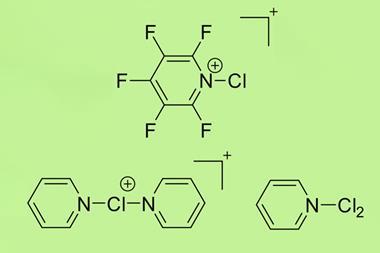
Tom Lectka from Johns Hopkins University in Baltimore has been chasing fluoronium ions on-and-off since he was a graduate student. ‘Every undergraduate in organic chemistry is familiar with bromonium, iodonium and chloronium ions as important reactive intermediates, but you never saw fluoronium ions quoted,’ he says.
At various points in his career, Lectka resurrected the search, developing several candidate molecules to try and observe a fluoronium ion by NMR spectroscopy. ‘Every one of those failed miserably,’ he muses. Eventually, he realised that he was on a hiding to nothing and put the project on the back burner for a few years.
‘I’m now pushing 50 and I wanted to work on a project that I enjoy, rather than trying to satisfy some funding agency,’ he says. ‘I also had a couple of students who were interested.’ So the team approached things from a different angle – generating fluoronium in solution as a reactive intermediate and using indirect physical chemistry to infer its existence from the products of the reaction.
Lectka and his team designed a molecule with a rigid framework, where a fluorine atom is held very close to a reactive leaving group. Heating this in a nucleophilic solvent like an alcohol leads to substitution reactions. Such reactions could follow a variety of different mechanisms, including one that involves one of the lone pairs of electrons on the fluorine displacing the leaving group to make a fluoronium cation, which can then be attacked by the solvent molecule to give the product.
The team found that the reactions produced a perfect 1:1 mixture of two isomeric products, which strongly supports the existence of the symmetrical fluoronium ion that can be attacked at two equivalent sites. The team backed up these experiments with theoretical calculations.
Antonio Togni from the Swiss Federal Institute of Technology in Zurich compliments the group’s efforts. ‘It completes the list of halonium ions, and constitutes the basis for making something more stable and even isolable.’ Togni says that that kind of study would tell a lot more about the nature of the bonding in these species.
Lectka agrees, saying that the team is trying to make molecules that can be studied more directly, using fast techniques like time-resolved Raman spectroscopy to look at the vibrations of the C–F–C bonds.
While Togni says that the result will probably not have drastic effects on synthetic chemistry, it is the kind of work that ends up in textbooks. ‘I’m going to incorporate it into my lecture courses straightaway,’ he says.
References
M D Struble et al, Science, 2013, DOI:10.1126/science.1231247







No comments yet